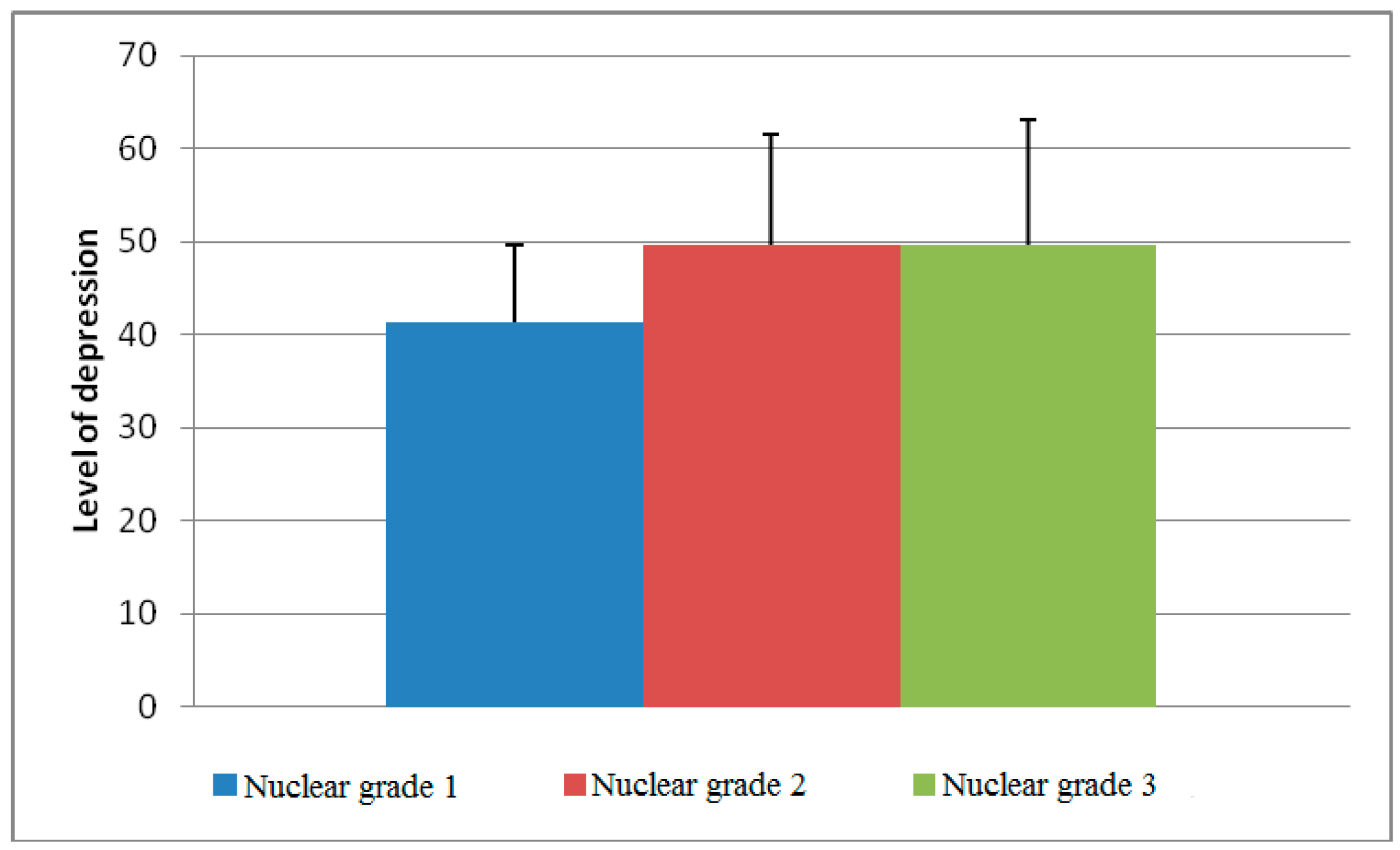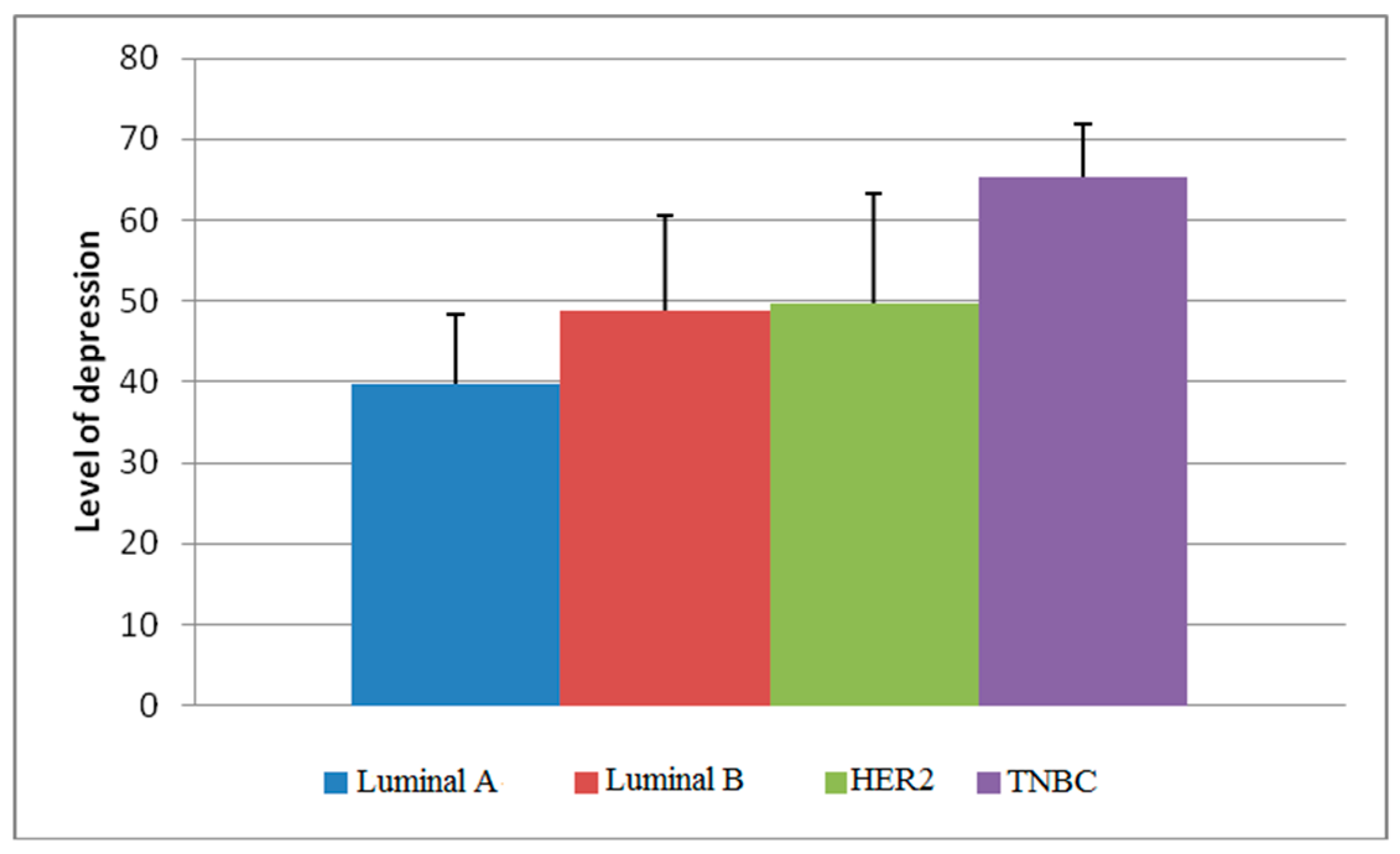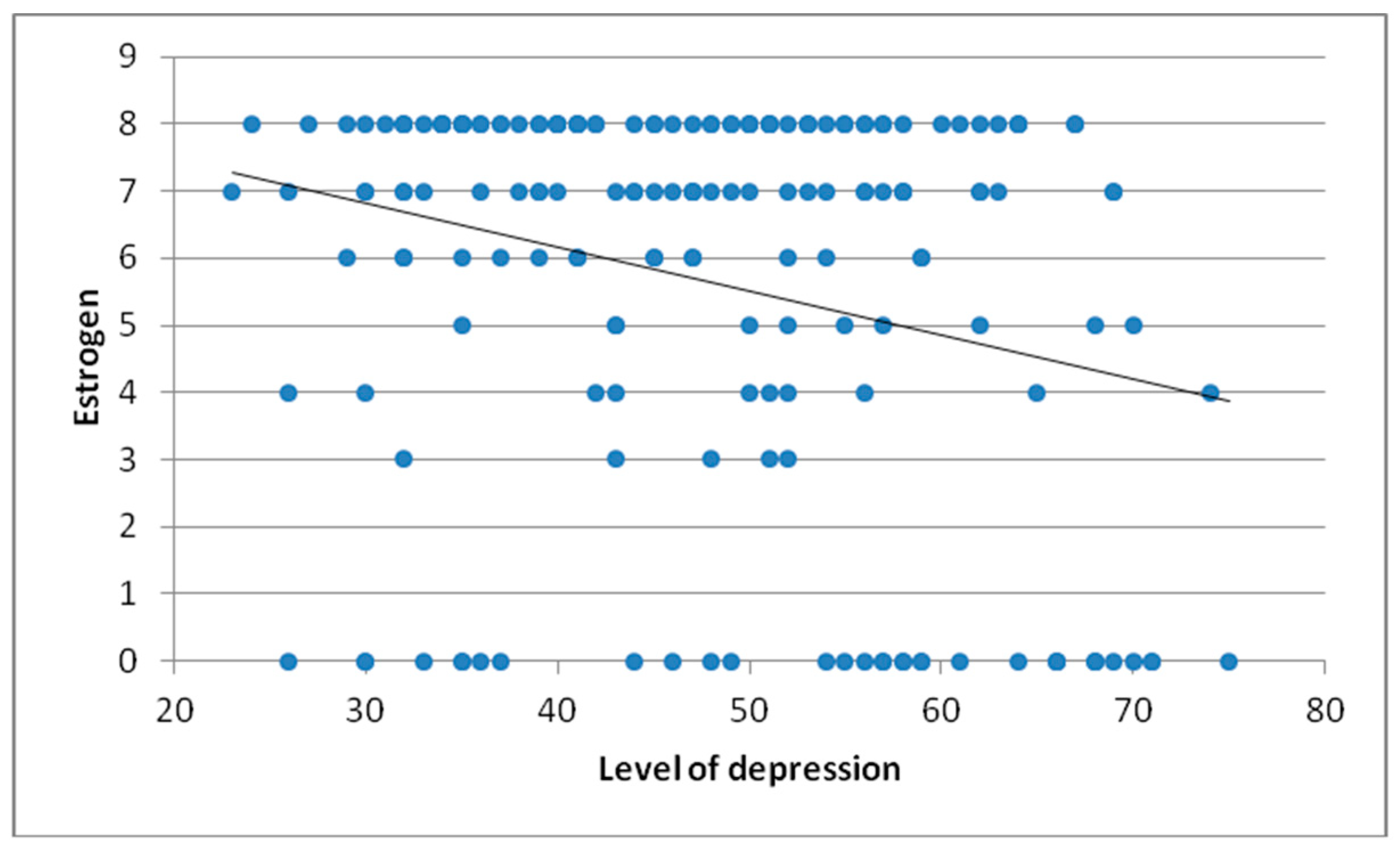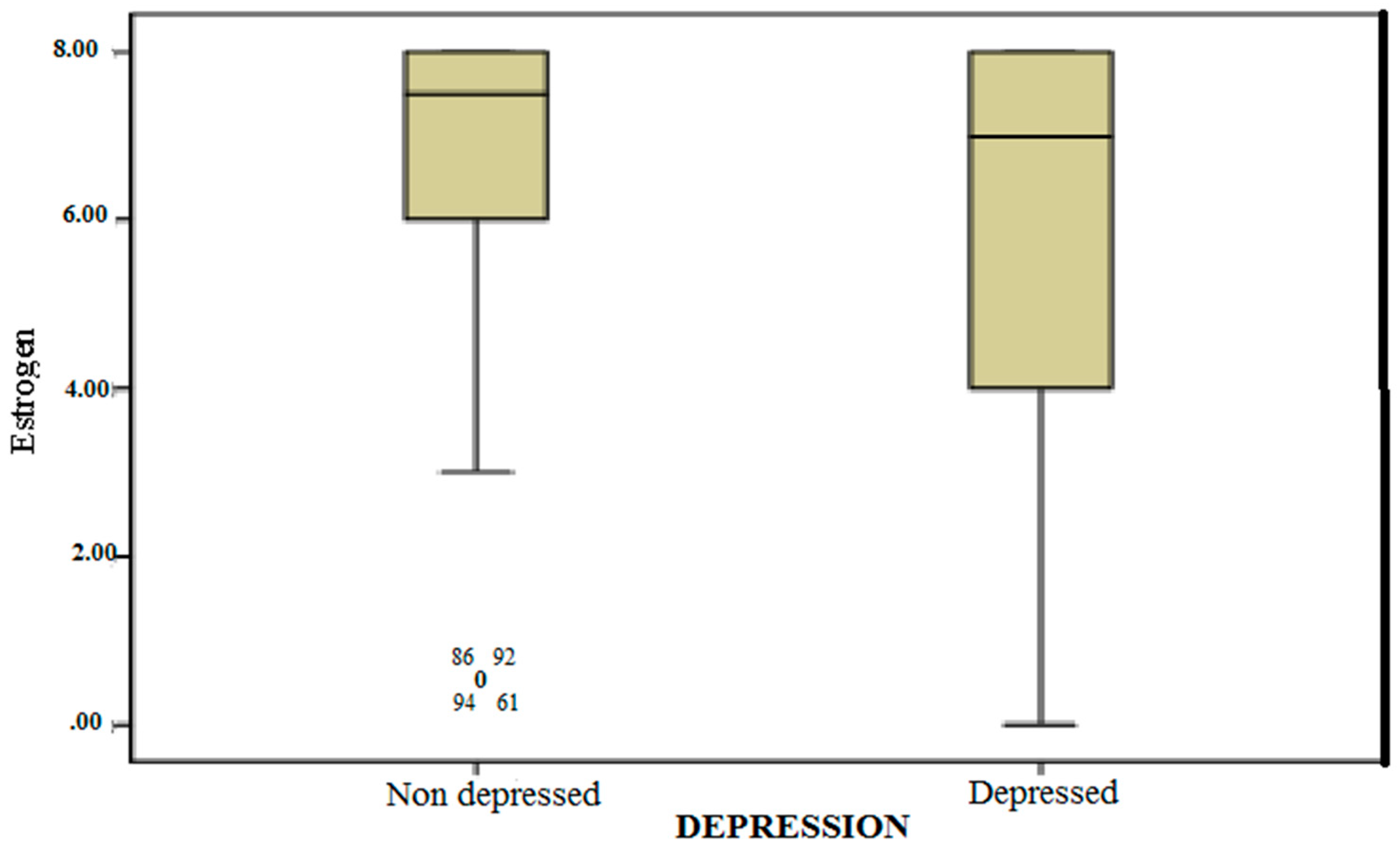Correlation of Clinicopathological Characteristics of Breast Carcinoma and Depression
Abstract
1. Introduction
2. Materials and Methods
2.1. Study Design
2.2. Pathohistological Analysis and Immunohistochemical Method
2.3. Depression Evaluation
2.4. Statistical Analysis of Data
3. Results
General Characteristics
4. Discussion
5. Conclusions
Author Contributions
Funding
Acknowledgments
Conflicts of Interest
References
- Xiao, Y.; Ke, Y.; Wu, S.; Huang, S.; Li, S.; Lv, Z.; Yeoh, E.; Lao, X.; Wong, S.; Kim, J.H.; et al. Association between whole grain intake and breast cancer risk: A systematic review and meta-analysis of observational studies. Nutr. J. 2018, 17, 87. [Google Scholar] [CrossRef] [PubMed]
- Ju, H.B.; Kang, E.C.; Jeon, D.W.; Kim, T.H.; Moon, J.J.; Kim, S.J.; Choi, J.-M.; Jung, D.-U. Associations Among Plasma Stress Markers and Symptoms of Anxiety and Depression in Patients with Breast Cancer Following Surgery. Psychiatry Investig. 2018, 15, 133–140. [Google Scholar] [CrossRef] [PubMed]
- Tavoli, A.; Mohagheghi, M.A.; Montazeri, A.; Roshan, R.; Tavoli, Z.; Omidvari, S. Anxiety and depression in patients with gastrointestinal cancer: Does knowledge of cancer diagnosis matter? BMC Gastroenterol. 2007, 7, 28. [Google Scholar] [CrossRef] [PubMed]
- Tojal, C.; Costa, R. Depressive symptoms and mental adjustment in women with breast cancer. Psychooncology 2015, 24, 1060–1065. [Google Scholar] [CrossRef] [PubMed]
- Zainal, N.Z.; Nik-Jaafar, N.R.; Baharudin, A.; Sabki, Z.A.; Ng, C.G. Prevalence of Depression in Breast Cancer Survivors: A Systematic Review of Observational Studies. Asian Pac. J. Cancer Prev. 2013, 14, 2649–2656. [Google Scholar] [CrossRef] [PubMed]
- Fann, J.R.; Thomas-Rich, A.M.; Katon, W.J.; Cowley, D.; Pepping, M.; Mc-Gregor, B.A.; Gralow, J. Major depression after breast cancer: A review of epidemiology and treatment. Gen. Hosp. Psychiatry 2008, 30, 112–126. [Google Scholar] [CrossRef] [PubMed]
- İzci, F.; İlgün, A.S.; Fındıklı, E.; Özmen, V. Psychiatric Symptoms and Psychosocial Problems in Patients with Breast Cancer. J. Breast Health 2016, 12, 94–101. [Google Scholar] [CrossRef] [PubMed]
- Oerlemans, M.E.; van den Akker, M.; Schuurman, A.G.; Kellen, E.; Buntinx, F. A meta-analysis on depression and subsequent cancer risk. Clin. Pract. Epidemiol. Ment. Health 2007, 3, 29. [Google Scholar] [CrossRef] [PubMed]
- Ahn, H.K.; Bae, J.H.; Ahn, H.Y.; Hwang, I.C. Risk of cancer among patients with depressive disorder: A meta-analysis and implications. Psychooncology 2016, 25, 1393–1399. [Google Scholar] [CrossRef] [PubMed]
- Ates, O.; Soylu, C.; Babacan, T.; Sarici, F.; Kertmen, N.; Allen, D.; Sever, A.R.; Altundag, K. Assessment of psychosocial factors and distress in women having adjuvant endocrine therapy for breast cancer: The relationship among emotional distress and patient and treatment-related factors. Springerplus 2016, 5, 486. [Google Scholar] [CrossRef] [PubMed][Green Version]
- Jacob, L.; Hadji, P.; Albert, U.S.; Kalder, M.; Kostev, K. Impact of disease management programs on women with breast cancer in Germany. Breast Cancer Res. Treat. 2015, 153, 391–395. [Google Scholar] [CrossRef] [PubMed]
- Brierley, J.D.; Gospodarowicz, M.K.; Wittekind, C. TNM Classification of Malignant Tumours, 8th ed.; John Wiley & Sons, Inc.: Oxford, UK; Hoboken, NJ, USA, 2017. [Google Scholar]
- Bancroft, J.D.; Gamble, M. Theory and Practice of Histological Techniques, 7th ed.; Churchill Livingstone: Edeinburgh, UK; London, UK; Oxford, UK; New York, NY, USA, 2012. [Google Scholar]
- Tunel, M.; Vural, A.; Evlice, Y.E.; Tamam, L. Meme Kanserli Hastalarda Psikiyatrik Sorunlar. Arşiv Kaynak Tarama Derg. 2012, 21, 189–219. [Google Scholar]
- Feng, F.; Yang, J.; Tong, L.; Yuan, S.; Tian, Y.; Hong, L.; Wang, W.; Zhang, H. Substance P immunoreactive nerve fibres are related to gastric cancer differentiation status and could promote proliferation and migration of gastric cancer cells. Cell Biol. Int. 2011, 35, 623–629. [Google Scholar] [CrossRef] [PubMed]
- Munoz, M.; Covenas, R.; Esteban, F.; Redondo, M. The substance P/NK-1 receptor system: NK-1 receptor antagonists as anti-cancer drugs. J. Biosci. 2015, 40, 441–463. [Google Scholar] [CrossRef] [PubMed]
- Li, M.; Kouzmina, E.; McCusker, M.; Rodin, D.; Boutros, P.C.; Paige, C.J.; Rodin, G. Pro- and anti-inflammatory cytokine associations with major depression in cancer patients. Psycho-Oncology 2017, 26, 2149–2156. [Google Scholar] [CrossRef] [PubMed]
- Ho, S.S.; So, W.K.; Leung, D.Y.; Lai, E.T.; Chan, C.W. Anxiety, depression and quality of life in Chinesewomen with breastcancer during and aftertreatment: A comparativeevaluation. Eur. J. Oncol. Nurs. 2013, 17, 877–882. [Google Scholar] [CrossRef] [PubMed]
- Rezaei, M.; Elyasi, F.; Janbabai, G.; Moosazadeh, M.; Hamzehgardeshi, Z. Factors Influencing Body Image in Women with Breast Cancer: A Comprehensive Literature Review. Iran. Red Crescent Med. J. 2016, 18, e39465. [Google Scholar] [CrossRef] [PubMed]
- Bhattacharyya, S.; Bhattacherjee, S.; Mandal, T.; Das, D.K. Depression in cancer patients undergoing chemotherapy in a tertiary care hospital of North Bengal, India. Indian J. Public Health 2017, 61, 14–18. [Google Scholar] [CrossRef] [PubMed]
- Kadan-Lottick, N.S.; Vanderwerker, L.C.; Bkock, S.D.; Zhang, B.; Prigerson, H.G. Psychiatric disorders and mental health service use in patients with advanced cancer. Cancer 2005, 104, 2872–2881. [Google Scholar] [CrossRef]
- Karakoyun-Celik, O.; Gorken, I.; Sahin, S.; Orcin, E.; Alanyali, H.; Kinay, M. Depression and anxiety levels in woman under follow-up for breast cancer: Relationship to coping with cancer and quality of life. Med. Oncol. 2010, 27, 108–113. [Google Scholar] [CrossRef]
- Shakeri, J.; Golshani, S.; Jalilian, E.; Farnia, V.; Nooripour, R.; Alikhani, M.; Kianoosh, Y. Studying the amount of depression and its role in predicting the quality of life of women with breast cancer. Asian Pac. J. Cancer Prev. 2016, 17, 643–646. [Google Scholar] [CrossRef] [PubMed]
- Chen, X.; Lu, W.; Zheng, Y.; Gu, K.; Chen, Z.; Zheng, W.; Shu, X.O. Exercise, tea consumption, and depression among breast cancer survivors. J. Clin. Oncol. 2010, 28, 991–998. [Google Scholar] [CrossRef] [PubMed]
- Purkayastha, D.; Venkateswaran, C.; Nayar, K.; Unnikrishnan, U.G. Prevalence of depression in breast cancer patients and its association with their quality of life: A cross-sectional observational study. Indian J. Palliat. Care 2017, 23, 268–273. [Google Scholar] [PubMed]
- Bener, A.; Alsulaiman, R.; Doodson, L.; Agathangelou, T. Depression, hopelessness and social support among breast cancer patients: In highly endogamous population. Asian Pac. J. Cancer Prev. 2017, 18, 1889–1896. [Google Scholar] [PubMed]
- Broeckel, J.A.; Jacobsen, P.B.; Balducci, L.; Horton, J.; Lyman, G.H. Quality of life after adjuvant chemotherapy for breast cancer. Breast Cancer Res. Treat. 2000, 62, 141–150. [Google Scholar] [CrossRef] [PubMed]
- Speer, J.J.; Hillenberg, B.; Sugrue, D.P.; Blacker, C.; Kresge, C.L.; Decker, V.B.; Zakalik, D.; Decker, D.A. Study of sexual functioning determinants in breast cancer survivors. Breast J. 2005, 11, 440–447. [Google Scholar] [CrossRef]
- Christie, K.M.; Meyerowitz, B.E.; Maly, R.C. Depression and sexual adjustment following breast cancer in low-income hispanic and non-hispanic white women. Psychooncology 2010, 19, 1069–1077. [Google Scholar] [CrossRef]
- Begovic-Juhant, A.; Chmielewski, A.; Iwuagwu, S.; Chapman, L.A. Impact of body image on depression and quality of life among women with breast cancer. J. Psychosoc. Oncol. 2012, 30, 446–460. [Google Scholar] [CrossRef]
- Mehnert, A.; Koch, U. Psychological comorbidity and health-related quality of life and its association with awareness, utilization, and need for psychosocial support in a cancer register-based sample of long-term breast cancer survivors. J. Psychosom. Res. 2008, 64, 383–391. [Google Scholar] [CrossRef]
- Fradelos, E.C.; Papathanasiou, I.V.; Veneti, A.; Daglas, A.; Christodoulou, E.; Zyga, S.; Kourakos, M. Psychological distress and resilience in women diagnosed with breast cancer in Greece. Asian Pac. J. Cancer Prev. 2017, 18, 2545–2550. [Google Scholar]
- Pumo, V.; Milone, G.; Iacono, M.; Giuliano, S.R.; Di Mari, A.; Lopiano, C.; Bordonaro, S.; Tralongo, P. Psychological and sexual disorders in long-term breast cancer survivors. Cancer Manag. Res. 2012, 4, 61–65. [Google Scholar] [PubMed]
- Rajabizadeh, G.; Mansoori, S.M.; Shakibi, M.R.; Ramazani, M.R. Determination of factors related to depression in cancer patients of the oncology ward in Kerman. J. Kerman Univ. Med. Sci. 2005, 12, 142–147. [Google Scholar]
- Osborne, R.H.; Elsworth, G.R.; Hopper, J.L. Age-specific norms and determinants of anxiety and depression in 731 women with breast cancer recruited through a population-based cancer registry. Eur. J. Cancer 2003, 39, 755–762. [Google Scholar] [CrossRef]
- Christensen, S.; Zachariae, R.; Jensen, A.B.; Michael Vaeth, M.; Moller, S.; Ravnsbæk, J.; von der Maase, H. Prevalence and risk of depressive symptoms 3–4 months post-surgery in a nationwide cohort study of Danish women treated for early stage breast-cancer. Breast Cancer Res. Treat. 2009, 113, 339–355. [Google Scholar] [CrossRef] [PubMed]
- Burgess, C.; Cornelius, V.; Love, S.; Graham, J.; Richards, M.; Ramirez, A. Depression and anxiety in women with early breast cancer: Five year observational cohort study. BMJ 2005, 330, 702–706. [Google Scholar] [CrossRef] [PubMed]
- Hopwood, P.; Howell, A.; Maguire, P. Psychiatric morbidity in patients with advanced cancer of the breast: Prevalence measured by two self-rating questionnaires. Br. J. Cancer 1991, 64, 349–352. [Google Scholar] [CrossRef] [PubMed][Green Version]
- Den Oudsten, B.L.; Van Heck, G.L.; Van der Steeg, A.F.; Roukema, J.A.; De Vries, J. The Whoqol-100 has good psychometric properties in breast cancer patients. J. Clin. Epidemiol. 2009, 62, 195–205. [Google Scholar] [CrossRef] [PubMed]
- Hui, L.; Huang, T.; Lian, J.; Zhou, F.; Gao, C.; Lin, Y.; Nan, K.; Li, Z.; Wei, Y. Potential prognostic value of clinical characteristics, hormone status and major depressive disorder in breast cancer. Future Oncol. 2017, 13, 1493–1503. [Google Scholar] [CrossRef] [PubMed]
- Guo, X.; Xu, J.; Ying, E.; Yu, Z.; Sun, T. Correlation between hormone receptor status and depressive symptoms in patients with metastatic breast cancer. Oncotarget 2017, 8, 50774–50781. [Google Scholar] [CrossRef] [PubMed]
- Kishan, A.U.; Wang, P.C.; Sharif, J.; Kupelian, P.A.; Steinberg, M.L.; McCloskey, S.A. Clinical indicators of psychosocial distress predict for acute radiation-induced fatigue in patients receiving adjuvant radiation therapy for breast cancer: An analysis of patient-reported outcomes. Int. J. Radiat. Oncol. Biol. Phys. 2016, 95, 946–955. [Google Scholar] [CrossRef] [PubMed]
- Huang, T.; Zhou, F.; Wang-Johanning, F.; Nan, K.; Wei, Y. Depression accelerates the development of gastric cancer through reactive oxygen species-activated ABL1 (Review). Oncol. Rep. 2016, 36, 2435–2443. [Google Scholar] [CrossRef] [PubMed]
- Muñoz, M.; González-Ortega, A.; Salinas-Martín, M.V.; Carranza, A.; Garcia-Recio, S.; Almendro, V.; Coveñas, R. The neurokinin-1 receptor antagonist aprepitant is a promising candidate for the treatment of breast cancer. Int. J. Oncol. 2014, 45, 1658–1672. [Google Scholar] [CrossRef] [PubMed]






| Variable | Mean ± SD or Frequency (%) |
|---|---|
| Age | 60.48 ± 12.97 |
| The time from finding out the diagnosis | 9.67 ± 14.08 |
| Urbanity | |
| village | 33 (17%) |
| town | 161 (83%) |
| Employment | |
| employed | 64 (33.0%) |
| retired | 92 (47.4%) |
| unemployed | 38 (19.6%) |
| Stage | |
| 1 | 57 (32.9) |
| 2 | 84 (48.6%) |
| 3 | 13 (7.5) |
| 4 | 19 (11.0) |
| Histological type | |
| ductal | 157 (84.9%) |
| lobular | 21 (11.4%) |
| the others | 7 (3.8%) |
| Molecular subtype of breast cancer (BC) | |
| Luminal A | 30 (19.6%) |
| Luminal B | 86 (56.2%) |
| HER2+ | 28 (18.3%) |
| TNBC | 9 (5.9%) |
| Categories of depression | |
| without depression | 63 (32.5%) |
| mild | 53 (27.3%) |
| moderate | 47 (24.2%) |
| marked | 27 (13.9%) |
| severe | 4 (2.1%) |
| Variable | Level of Depression (mean ± SD) | p |
|---|---|---|
| Histological grade | ||
| 1 | 42.35 ± 10.43 | 0.040 |
| 2 | 48.90 ± 11.97 | |
| 3 | 49.77 ± 12.55 | |
| Nuclear grade | ||
| 1 | 41.33 ± 8.30 | 0.011 |
| 2 | 49.55 ± 12.04 | |
| 3 | 49.56 ± 13.56 | |
| Lymphatic invasion | ||
| No | 43.65 ± 11.45 | 0.014 |
| Yes | 49.03 ± 11.85 | |
| Immunophenotypes | ||
| Luminal A | 39.80 ± 8.47 | <0.0005 |
| Luminal B | 48.70 ± 11.88 | |
| HER2 | 49.68 ± 13.64 | |
| TNBC | 65.33 ± 6.60 | |
| Ki67 | ||
| low | 39.32 ± 8.52 | <0.0005 |
| medium | 49.18 ± 10.14 | |
| high | 50.58 ± 13.92 |
| Variable | Non-Depressed | Depressed | p |
|---|---|---|---|
| Estrogen | 7.50 (6.00–8.00) * | 7.00 (4.00–8.00) * | 0.023 |
| Progesterone | 6.00 (1.50–7.50) * | 4.00 (0.00–7.00) * | 0.047 |
| Lymphatic invasion | |||
| No | 20 (46.5%) | 23 (53.5%) | 0.039 |
| Yes | 25 (26.9 | 68 (73.1%) | |
| Immunophenotypes | |||
| Luminal A | 19 (63.3%) | 11 (36.7%) | <0.0005 |
| Luminal B | 22 (25.6%) | 64 (74.4%) | |
| HER2 | 9 (32.1%) | 19 (67.9%) | |
| TNBC | 0 (0.0%) | 19 (100.0%) | |
| Ki67 | |||
| low | 19 (67.9%) | 9 (32.1%) | <0.0005 |
| medium | 4 (11.8%) | 30 (88.2%) | |
| high | 24 (31.2%) | 53 (68.8%) |
| Variable | Univariate Regression | Multivariate Regression | ||
|---|---|---|---|---|
| Odds Ratio | p | Odds Ratio | p | |
| Age | 1.026 (1.103–1.051) | 0.029 | ||
| Desmoplasia | 2.543 (1.400–4.616) | 0.002 | 2.452 (1.233–4.876) | 0.011 |
| Progesterone | 0.906 (0.821–1.000) | 0.050 | ||
| Estrogen | 0.893 (0.795–1.002) | 0.053 | ||
| Non luminal A | 5.126 (2.128–11.955) | <0.0005 | 4.454 (1.505–13.178) | 0.007 |
| Lymphatic invasion | 2.365 (1.112–5.030) | 0.025 | ||
| Histological type | 0.600 (0.325–1.109) | 0.103 | ||
| Histological grade | 1.498 (0.887–2.527) | 0.130 | ||
| Nuclear grade | 1.351 (0.779–2.344) | 0.284 | ||
| Ki67 | 1.784 (1.146–2.777) | 0.010 | ||
| Perineural invasion | 1.292 (0.622–2.684) | 0.492 | ||
| Vascular invasion | 1.561 (0.721–3.378) | 0.258 | ||
| In situ | 0.745 (0.401–1.381) | 0.350 | ||
| HER2 | 1.376 (0.664–2.853) | 0.391 | ||
| T | 1.226 (0.850–1.768) | 0.276 | ||
| N | 1.373 (0.916–2.058) | 0.124 | ||
| M | 0.630 (0.137–2.904) | 0.553 | ||
© 2019 by the authors. Licensee MDPI, Basel, Switzerland. This article is an open access article distributed under the terms and conditions of the Creative Commons Attribution (CC BY) license (http://creativecommons.org/licenses/by/4.0/).
Share and Cite
Ilic, M.B.; Mitrovic, S.L.; Vuletic, M.S.; Radivojcevic, U.M.; Janjic, V.S.; Stanković, V.D.; Vojinovic, R.H.; Stojadinovic, D.S.; Radmanovic, B.R.; Jovanovic, D.V. Correlation of Clinicopathological Characteristics of Breast Carcinoma and Depression. Healthcare 2019, 7, 107. https://doi.org/10.3390/healthcare7030107
Ilic MB, Mitrovic SL, Vuletic MS, Radivojcevic UM, Janjic VS, Stanković VD, Vojinovic RH, Stojadinovic DS, Radmanovic BR, Jovanovic DV. Correlation of Clinicopathological Characteristics of Breast Carcinoma and Depression. Healthcare. 2019; 7(3):107. https://doi.org/10.3390/healthcare7030107
Chicago/Turabian StyleIlic, Milena B, Slobodanka Lj Mitrovic, Milena S Vuletic, Uros M Radivojcevic, Vladimir S Janjic, Vesna D Stanković, Radisa H Vojinovic, Dobrivoje S Stojadinovic, Branimir R Radmanovic, and Dalibor V Jovanovic. 2019. "Correlation of Clinicopathological Characteristics of Breast Carcinoma and Depression" Healthcare 7, no. 3: 107. https://doi.org/10.3390/healthcare7030107
APA StyleIlic, M. B., Mitrovic, S. L., Vuletic, M. S., Radivojcevic, U. M., Janjic, V. S., Stanković, V. D., Vojinovic, R. H., Stojadinovic, D. S., Radmanovic, B. R., & Jovanovic, D. V. (2019). Correlation of Clinicopathological Characteristics of Breast Carcinoma and Depression. Healthcare, 7(3), 107. https://doi.org/10.3390/healthcare7030107




